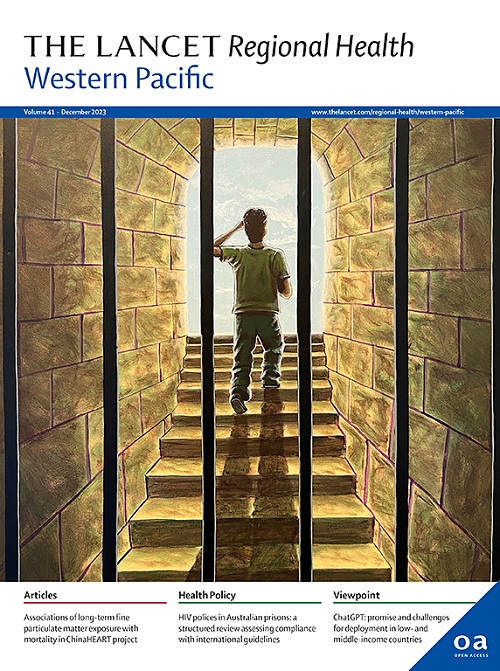中国温度相关伤害发生风险的时间变化及其驱动因素:2006 - 2021年全国病例交叉研究
IF 8.1
1区 医学
Q1 HEALTH CARE SCIENCES & SERVICES
引用次数: 0
摘要
虽然一些研究已经证明环境温度与损伤之间存在关联,但温度相关损伤风险的时间趋势仍然未知。本研究旨在探讨温度变化对损伤发生率的影响,并探讨其驱动因素。方法采用时间分层病例交叉研究方法,对全国243家监测医院2006-2013年和2014-2021年的1150多万例伤害病例进行分析,采用条件logistic回归模型结合分布滞后非线性模型(DLNM)对温度与伤害发生率的关系进行比较。基于混合效应线性模型和随机森林算法,进一步探讨了2006-2013年至2014-2021年时间变化的社会经济驱动因素。该研究涵盖了2006年至2021年期间的11512467起伤害案件。与2014年和2021年相比,2006 - 2013年温度与伤害发生率呈线性关系,斜率更陡。2006-2013年,温度每升高1°C的超额风险(ER)为1.08% (95% CI: 1.06%, 1.10%),显著高于2014-2021年的0.83% (95% CI: 0.82%, 0.84%),下降23.31% (95% CI: 21.53%, 24.95%)。在31个省份中,下降率为74.19%,主要集中在沿海地区。影响温度相关伤害风险时间变化的主要因素是儿童抚养比、每100户农村家庭空调拥有率和出生率。总体而言,在过去二十年中,中国与温度相关的伤害风险有所下降,人口和社会经济因素在这一下降中发挥了关键作用。国家自然科学基金。本文章由计算机程序翻译,如有差异,请以英文原文为准。
The temporal shift of temperature-related injury incidence risk and its driving factors in China: a nationwide case-crossover study from 2006 to 2021
Background
Although several studies have demonstrated an association between ambient temperature and injury, the temporal trend of temperature-related injury risk remains unknown. This study aimed to examine changes in the effect of temperature on injury incidence and to explore its driving factors.
Methods
A time-stratified case-crossover study including over 11.5 million injury cases from 243 surveillance hospitals in China was conducted, and the injury incidence risks associated with temperature during the periods 2006–2013 and 2014–2021 were compared using conditional logistic regression model combined with distributed lag nonlinear model (DLNM). The socio-economic driving factors of the temporal change from 2006–2013 to 2014–2021 were further explored based on mixed-effects linear model and random forest algorithm.
Findings
The study encompassed a total of 11,512,467 injury cases from 2006 to 2021. The temperature-injury incidence relationship was linear, exhibiting a steeper slope between 2006 and 2013 compared to 2014 and 2021. The excess risk (ER) for per 1 °C increase in temperature was 1.08% (95% CI: 1.06%, 1.10%) for 2006–2013, which was significantly higher than the 0.83% (95% CI: 0.82%, 0.84%) for 2014–2021, representing a 23.31% (95% CI: 21.53%, 24.95%) decrease. Among 31 provinces, 74.19% experienced a decline in ER, predominantly in coastal regions. The primary factors influencing this temporal shift in temperature-related injury risk were identified as the child dependency ratio, air conditioners ownership per 100 rural households, and the birth rate.
Interpretation
Overall, the risk of temperature-related injuries in China has decreased over the past two decades, with demographic and socioeconomic factors playing pivotal roles in this decline.
Funding
National Natural Science Foundation of China.
求助全文
通过发布文献求助,成功后即可免费获取论文全文。
去求助
来源期刊

The Lancet Regional Health: Western Pacific
Medicine-Pediatrics, Perinatology and Child Health
CiteScore
8.80
自引率
2.80%
发文量
305
审稿时长
11 weeks
期刊介绍:
The Lancet Regional Health – Western Pacific, a gold open access journal, is an integral part of The Lancet's global initiative advocating for healthcare quality and access worldwide. It aims to advance clinical practice and health policy in the Western Pacific region, contributing to enhanced health outcomes. The journal publishes high-quality original research shedding light on clinical practice and health policy in the region. It also includes reviews, commentaries, and opinion pieces covering diverse regional health topics, such as infectious diseases, non-communicable diseases, child and adolescent health, maternal and reproductive health, aging health, mental health, the health workforce and systems, and health policy.
 求助内容:
求助内容: 应助结果提醒方式:
应助结果提醒方式:


